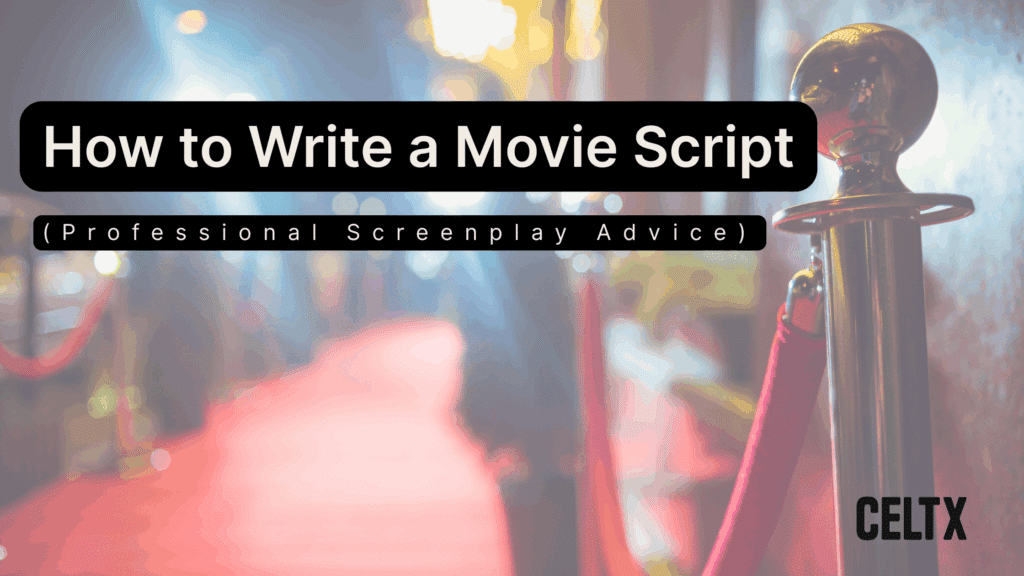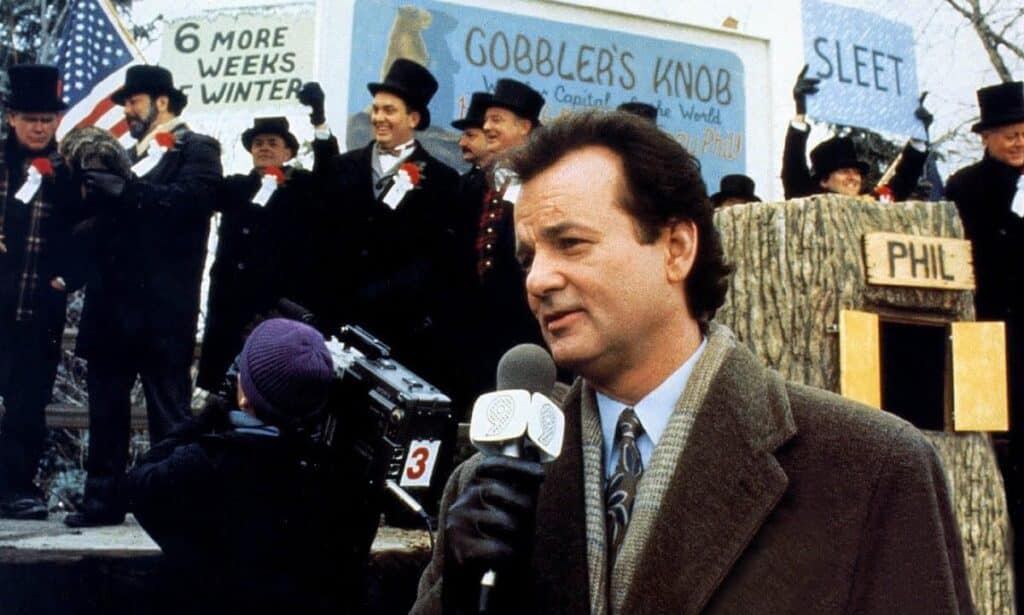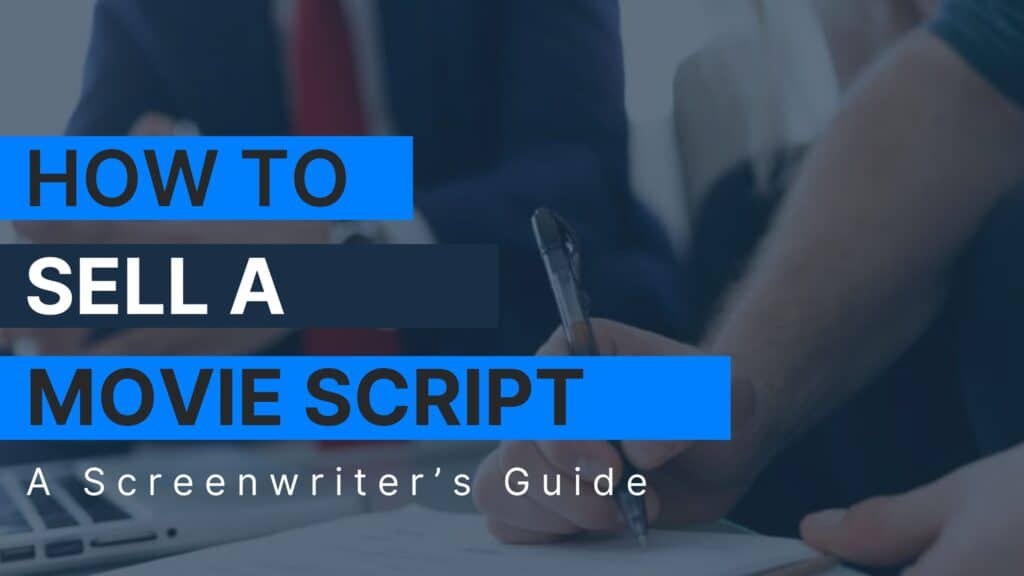
Every movie you’ve ever loved started with a script. That script wasn’t just words on a page, but the blueprint for everything that followed: direction, acting, cinematography, editing, and even marketing.
If you have an idea for a story that you’ve dreamed will come alive on screen, learning how to write a movie script is the essential first step.
However, screenwriting isn’t like writing a novel or a short story. A screenplay requires specific formatting, a clear structure, and a delicate balance between dialogue, action, and pacing. It’s both an art and a craft.
And in today’s blog, we’ll break down exactly what a movie script is and how to write one step-by-step.
We’ll also look at tools, like Celtx, that can make your journey from idea to finished screenplay smoother and more professional.

Want to write a movie script in a specific genre? Check out our Mastering the Art of Screenwriting series where we breakdown what it takes to create the best scripts for each genre, from horror to comedy!
Or, if you like, you can stay here for a more general overview of how to write a movie script. The choice is yours.
Table of Contents
- What is a Movie Script?
- How Are Movie Scripts Different From Other Scripts?
- How to Write a Movie Script: Step-by-Step Guide
- Tools to Help
- FAQs
- Conclusion
What is a Movie Script?
A movie script (also called a screenplay) is a written document that outlines the story, characters, and dialogue of a film.
And a script is not just for the writer. It’s a collaborative tool used by directors, producers, cinematographers, and actors to bring the story to life.
A standard screenplay is usually 90-120 pages long, with one page roughly equating to one minute of screen time. The script follows strict formatting rules: Courier 12-point font, scene headings, action descriptions, and dialogue laid out in a standardized way.
These conventions ensure clarity and make the screenplay easy to read and produce.
A movie script includes:
- Scene headings, which indicate location and time of day (e.g. INT. COFFEE SHOP – NIGHT)
- Action lines, which describe what’s happening visually on screen
- Dialogue, the spoken lines of each character
- Parentheticals, short directions for how a line should be delivered (used sparingly)
- Transitions, used to indicate cuts, fades, or shifts between scenes
Without a script, there is no movie. It’s the foundation of everything that happens in production.
How Are Movie Scripts Different From Other Scripts?
While all screenplays share similarities, movie scripts are different from TV scripts, stage plays, or radio plays in key ways. Let’s explore those!
Length
We already know that movie scripts typically run 90-120 pages. Their TV counterparts vary by format, with sitcoms around 22-35 pages and hour-long dramas from 50-60 pages.
On the other hand, stage plays can run longer and rely more heavily on dialogue.
Structure
Movies are usually self-contained stories with a beginning, middle, and end. TV scripts are episodic, often ending with cliffhangers or setups for future episodes. While scripts written for screen tend to be more structured, play scripts allow more abstract structures since they’re limited to stage performance.

Formatting
Film scripts are focused on visuals and sound, what the audience sees and hears. When it comes to TV, scripts often include act breaks and specific timing for commercials. Stage directions and dialogue drive play scripts since the action is live.
Essentially, a movie script is a tightly crafted, visually oriented document designed to tell a complete short story in about two hours of screen time.
Want the 101 on formatting? Click here to find out How to Format a Script.
How to Write a Movie Script: Step-by-Step Guide
Writing a screenplay can feel overwhelming but breaking it into steps makes it manageable. Next, we’ll walk through the process of writing your own movie script from scratch.
Step 1 | Develop Your Story
Before you type FADE IN, you need a story worth telling. At this stage, don’t worry about formatting or structure. Instead, focus on the big picture.
Consider these four main elements:
- Premise – what is your story about?
- Theme – what is the underlying message or idea?
- Conflict – What obstacles do your characters face?
- Setting – where and when does your story take place?
As you’re working these things out, make sure to brainstorm freely. Write down every idea that excites you.
Once you have a premise and central conflict all condensed into a logline, you’ll have the seed of your story.
If you’re finding it tricky to come up with a strong, initial premise, ask yourself ‘what if’? A simple ‘what-if’ premise can help you focus on your idea.
- What if dinosaurs were cloned and put in a theme park? (Jurassic Park)
- What if a man had to relive the same day over and over again? (Groundhog Day)
- What if dreams could be infiltrated and manipulated? (Inception)

By asking ‘what if’, you open up a playground of possibilities that can lead to unique and engaging narratives.
CELTX TOP TIP: Ask yourself why this story and why now? The more personal and urgent your story feels to you, the more likely it is to resonate with audiences.
Step 2 | Create Your Characters
Characters drive stories. Yes, you can have a thrilling plot, but it can fall flat without compelling, believable characters:
- Protagonist (who is the central character, what do they want, and why can’t they easily get it?)
- Antagonist (who or what opposes the protagonist?)
- Supporting Cast (allies, mentors, sidekicks, or foils who add depth)
Once you’ve determined your characters, remember they need to be shaped by the world around them. To make your characters memorable, you must go beyond the basics of their name, age and favorite color!
Dig deeper into their:
Motivations and Flaws
A great character wants something desperately, but their flaws make achieving it difficult. For example, Tony Stark (Iron Man) wants to protect the world, but his arrogance and impulsiveness constantly get in the way.

External vs. Internal Goals
The external goal is what drives the plot, for example, winning a race or solving a mystery.
The internal goal is the personal transformation like learning to trust others or overcome fear. A satisfying character arc should tie these together.
Contrast Between Characters
Strong supporting characters often act as mirrors, foils or challengers to the protagonist. Think of Watson to Sherlock Holmes, or Samwise to Frodo.

Try writing a scene where your characters argue, even if it doesn’t end up in the script. This ‘stress test’ can reveal how their personalities clash or complement each other.
Use tools like character bios to flesh out details such as backstory, flaws, strengths, quirks and motivations for your characters. Strong characters make strong scripts.
Step 3 | Outline Your Script
Once you know your story and characters, it’s time to build a roadmap. Outlining your script will precent writer’s block and ensures your story has a coherent structure.
There are several plot outline approaches you can take to map out your script. Here are the most common:
- Beat Sheets: Break your story into key beats (major plot points)
- Three-Act Structure: Setup, confrontation, resolution
- Five-Act Structure: Expanded version of the three-act structure
- Hero’s Journey: A character leaves the familiar world, faces trials, and returns transformed.

We recommend a beat sheet if you’re just starting out, as it breaks down your story into clear steps. Your beat sheet might include:
- Opening Image
- Inciting Incident
- Plot Point One
- Midpoint
- Plot Point Two
- Climax
- Resolution
For our detailed guide on beat sheets, click here.
Step 4 | Write Your First Draft
Now comes the fun (and sometimes painful) part: putting words on the page. It’s time for your first draft!
Here are our top tips as you embark on converting your outline into a first draft:
Format Correctly
Use screenwriting software like Celtx to handle scene headings, dialogue, and action formatting automatically.
Write Visually
Movies are visual. Show what happens rather than explaining.
Keep Dialogue Natural
People don’t usually speak in long monologues. Your dialogue should reveal character and move the plot forward.
Don’t Edit too Early
Get the draft down before worrying about perfection.
Think of your first draft as clay. It’s rough, but it gives you something to shape.

CELTX TOP TIP: Set daily or weekly writing goals. For example, 5 pages a day gets you to a complete draft in about 3-4 weeks.
Step 5 | Revise and Polish
No one writes a perfect script on the first try. Rewriting is where the true magic happens.
Use out checklist below to help you revise once you’ve finished your first draft:
- Structure: Does your story build tension and resolve satisfyingly?
- Characters: Are arcs believable and engaging? Do supporting characters serve the plot?
- Dialogue: Is it concise, unique to each character, and purposeful?
- Pacing: Are scenes too long or too short? Does the story drag or feel rushed?
- Theme: Does the script communicate the message you intend?
It’s also a good idea to:
- Get feedback from trusted readers
- Do table reads to hear dialogue aloud
- Cut ruthlessly: every scene should serve the story
It’s important to remember that polishing can take multiple drafts, but each pass should make your script stronger.And to hear first hand about the scriptwriting experience, Film Courage conducted a fantastic interview with screenwriter Mike Thompson!
If you need some more inspiration, then reading scripts is about to become your new favorite hobby. Check out the BBC Writers script library right here.
Tools to Help You Write a Movie Script
Yes, there is dedicated screenwriting software out there to ensure you can stay focused on the writing itself.
But screenwriting software isn’t just about formatting. No, it streamlines the entire creative process.

Here at Celtx, we have one of the most popular platforms for both new and professional writers. Here’s how it can help:
Automatic Formatting
Focus on writing while we ensure your script meets industry formatting standards.
Index Cards and Beat Sheets
Plan your story arc visually before drafting using our integrated beat sheet and index card function. Seamlessly move between your outline and your script.
Collaboration Tools
Share with co-writers, directors, or producers in real-time.
Revision Tracking
Save versions and compare drafts easily.
Pre-Production Features
Move seamlessly from script to storyboarding, scheduling, and budgeting.

By using Celtx, you’re not just writing, but preparing your story for production.
FAQs
Most feature-length scripts are 90-120 pages. One page roughly equals one minute of screen time.
You can, but it’s time consuming to format manually. Dedicated software like Celtx saves time and ensures your script looks professional.
If you’re planning to pitch or sell your script and live in America, you can register it with the Copyright Office or WGA (Writers Guild of America).
A spec script is written to sell, focused on story and dialogue, whereas a shooting script is used in production and includes technical directions like camera angles and scene numbers.
Find out more about the differences here:
What is a Shooting Script (and is it Different than a Spec Script)?
What Is a Spec Script? (Definition, Examples & How to Write One)
It varies. Many professional scripts go through 5-10 drafts before production.
Conclusion
Writing a movie script is both a creative adventure and a disciplined craft. From developing your story and building compelling characters to outlining, drafting, and revising, each step brings you closer to transforming an idea into a finished screenplay.
While the process can seem daunting, breaking it into steps makes it manageable, and even fun. With tools like Celtx to handle formatting, collaboration, and revisions, you can focus on what matters most: telling a powerful story that resonates with audiences.
Remember, every great film started as a blank page. Your script could be next.

Ready to write your movie script? Start today. Open Celtx, sketch out your first beat sheet, and take the first step toward bringing your story to the big screen.
Because the only way to write a script… is to start writing.
Ready to write your own screenplay?
Bring your movie idea to life with Celtx — your all-in-one scriptwriting software.
Sign up free and start writing today
Up Next:

How to Sell a Movie Script
Writing your screenplay is just the beginning. The next challenge is getting it into the right hands. In our next guide, we’ll cover everything you need to know about pitching, agents, and how to sell your movie script.
